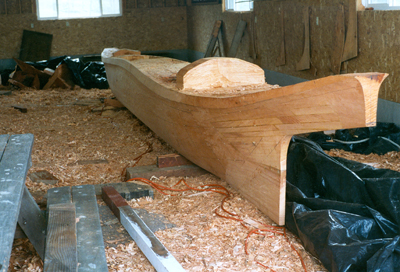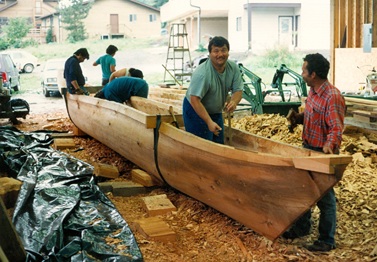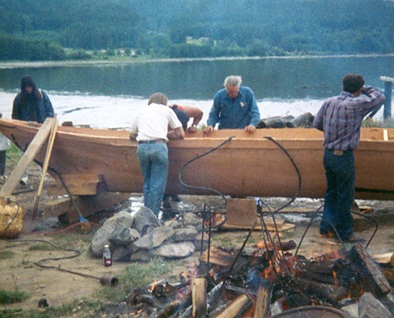In 1993, members of the Jamestown SíKlallam Tribe, with help from canoe carvers from other Tribes, harvested a 600 year old red cedar tree from Blyn and carved the Laxaynem.
Below are some images of that project.

The exterior begins to take shape.

The interior has been hollowed out. Cliff Prince is facing the camera.

Water is added to the canoe as the fire burns, in preparation for heating the rocks.
|
The general family/transportation canoes of the coast ranged from 18 feet to 35 feet, and were able to hold up to fifteen people and about 3 tons of weight. The depth of a canoe was at least three feet. The thickness of the canoe side in general was two fingers widths and the bottom was three fingers widths. When families moved to their summer fishing villages they often tied two canoes together and placed planks across the canoes, enabling them to haul more goods.
To insure consistent thickness of the canoe hull, small holes were drilled in the roughly hollowed hull and measured pegs made of yellow cedar were inserted in the holes. When the inside of the hull was carved away and the yellow cedar pegs reached, the carver knew the correct thickness for the sides of the canoe had been reached.
Once the shape was formed and adzed, then the canoe was ready to be steamed for its final shaping. If the steaming was done wrong, the canoe could crack or split in half. (While steaming Jamestown SíKlallam canoe Laxaynem, it softened so fast that it came close to splitting).
Thwarts lashed into place were used to control the shape. Starting early in the morning, rocks were heated to red hot in a fire pit not far from the outside of the canoe hull. Water was poured into the bottom of the canoe the hot rocks are dropped into the water. Using paddles or sticks the boiling water was washed up the sides of the canoe to help speed the softening. Mats were then placed over the canoe helping the steam soften the sides.
The outside bottom was sometimes scorched with lighted torches to add heat and harden the wood. Before the days of epoxy sealer, heated dogfish oil was rubbed into the canoe inside and out.
The life span of a canoe if used hard may be only ten years. If used only on occasion and well cared for, it can last thirty or more years.
The Jamestown SíKlallam Tribe repaints its canoes periodically.
|




